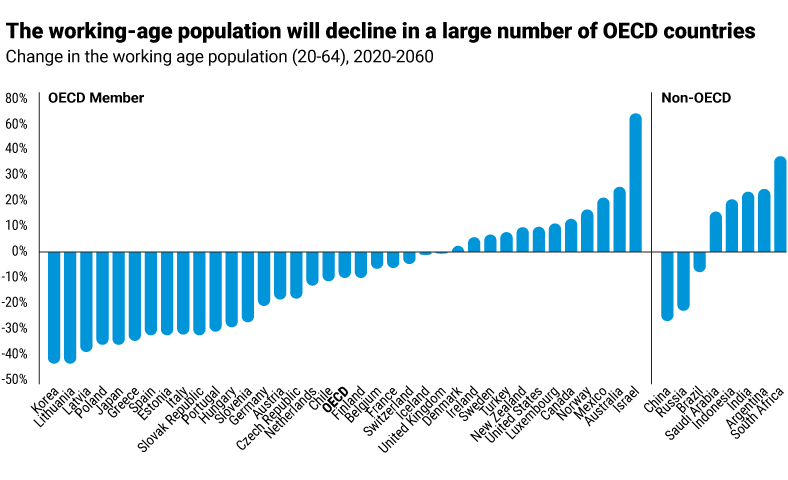Worldwide, the working-age population will see a 10% decrease by 2060.
With a rapidly aging global population due to declining birth rates and increased life expectancy, a smaller workforce will slow down economies and raise healthcare costs.
The implications of this aging population are shown in this infographic from the World Economic Forum.
The world is experiencing a seismic demographic shift—and no country is immune to the consequences.
While increasing life expectancy and declining birth rates are considered major achievements in modern science and healthcare, they will have a significant impact on future generations.
Today’s graphic relies on OECD data to demonstrate how the old-age to working-age ratio will change by 2060, highlighting some of the world’s fastest aging countries.
The Demographic Debacle
By 2050, there will be 10 billion people on earth, compared to 7.7 billion today—and many of them will be living longer.
As a result, the number of elderly people per 100 working-age people will nearly triple—from 20 in 1980, to 58 in 2060.
Populations are getting older in all OECD countries, yet there are clear differences in the pace of aging.
For instance, Japan holds the title for having the oldest population, with ⅓ of its citizens already over the age of 65.
By 2030, the country’s workforce is expected to fall by 8 million—leading to a major potential labor shortage.
In another example, while South Korea currently boasts a younger than average population, it will age rapidly and end up with the highest old-to-young ratio among developed countries.
A Declining Workforce
Globally, the working-age population will see a 10% decrease by 2060.
It will fall the most drastically by 35% or more in Greece, Japan, Korea, Latvia, Lithuania, and Poland.
On the other end of the scale, it will increase by more than 20% in Australia, Mexico, and Israel.
Israel’s notably higher increase of 67% is due to the country’s high fertility rate, which is comparable to “baby boom” numbers seen in the U.S. following the second World War.
As countries prepare for the coming decades, workforce shortages are just one of the impacts of aging populations already being felt.
Managing the Risks
There are many other social and economic risks that we can come to expect as the global population continues to age:
- The Squeezed Middle: With more people claiming pension benefits but less people paying income taxes, the shrinking workforce may be forced to pay higher taxes.
- Rising Healthcare Costs: Longer lives do not necessarily mean healthier lives, with those over 65 more likely to have at least one chronic disease and require expensive, long-term care.
- Economic Slowdown: Changing workforces may lead capital to flow away from rapidly aging countries to younger countries, shifting the global distribution of economic power.
The strain on pension systems is perhaps the most evident sign of a drastically aging population. Although the average retirement age is gradually increasing in many countries, people are saving insufficiently for their increased life span—resulting in an estimated $400 trillion deficit by 2050.
Pensions Under Pressure
A pension is promised, but not necessarily guaranteed.
Any changes made to existing government programs can alter the lives of future retirees entirely—but effective pension reforms that lessen the growing deficit are required urgently.
Towards a Better System
Certain countries are making great strides towards more sustainable pension systems, and the Global Pension Index suggests initiatives that governments can take into consideration, such as:
- Continuing to increase the age of retirement
- Increasing the level of savings—both inside and outside pension funds
- Increasing the coverage of private pensions across the labor force, including self-employed and contract employees, to provide improved integration between various pillars
- Preserving retirement funds by limiting the access to benefits before the retirement age
- Increasing the trust and confidence of all stakeholders by improving transparency of pension plans
Although 59% of employees are expecting to continue earning well into their retirement years, providing people with better incentives and options to make working at an older age easier could be crucial for ensuring continued economic growth.
Live Long and Prosper
As 2020 marks the beginning of the Decade of Healthy Ageing, the world is undoubtedly entering a pivotal period.
Countries all over the world face tremendous pressure to effectively manage their aging populations, but preparing for this demographic shift early will contribute to the economic advancement of countries, and allow populations—both young and old—to live long and prosper.
Guest Author: The World Economic Forum Katie Jones, Writer, Visual Capitalist This article is published in collaboration with Visual Capitalist.

![The problem of an aging population [Infographic] - featured image](https://cdn.propertyupdate.com.au/wp-content/uploads/2020/05/population.jpg)















